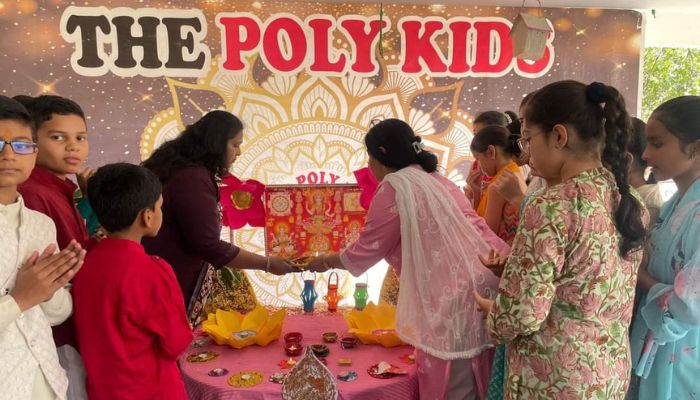Diwali Celebration for Kids: Embracing Tradition, Joy, and Safety

Diwali, the vibrant Festival of Lights, is a cherished time of year for families across India. Known for symbolizing the triumph of good over evil, Diwali is marked by beautiful diyas, colorful rangolis, and warm celebrations. For children, it’s an especially magical festival filled with lights, sweets, and joy. As we celebrate, it’s essential to create a safe, engaging, and educational experience for kids. This guide explores how to make Diwali memorable and meaningful for young ones, covering Diwali puja, rangoli making, cracker safety, and more.
1. Understanding the Significance of Diwali for Kids
Diwali provides a wonderful opportunity for kids to learn about Indian culture and values. By understanding the story of Lord Rama’s return to Ayodhya, children can appreciate the symbolism of light conquering darkness. Involving kids in Diwali preparations and traditions, such as decorating the house and performing Diwali puja, helps them form a strong bond with family values and cultural heritage.
2. Diwali Puja: Starting the Festivities with Meaning

One of Diwali’s most cherished traditions is the Diwali Puja, a ritual seeking blessings for happiness and prosperity. Inviting children to take part in the Diwali puja can make them feel included and provide them with valuable cultural insights. Here are ways to involve kids:
- Assign Simple Tasks: Allow kids to arrange flowers, set diyas, or offer sweets.
- Explain Each Ritual: Share the significance of each step in the puja to deepen their understanding.
By engaging in these small yet significant acts, children can develop a genuine respect for Diwali’s spiritual essence.
3. Rangoli Making: Unleashing Creativity and Joy

Rangoli, the colorful floor art, is a favorite Diwali activity for many kids. It not only brings beauty to the home but also lets kids express creativity and improve their motor skills. Here’s how to make rangoli-making a kid-friendly activity:
- Use Safe Materials: Encourage kids to use flower petals or colored rice for a safe experience.
- Start with Simple Patterns: Guide children in creating simple shapes or patterns, then help them fill in vibrant colors.
Rangoli art becomes a special family activity, enhancing the festive atmosphere and allowing kids to explore their artistic side.
4. Firecrackers: Ensuring Fun and Safety Together

For many children, Diwali is synonymous with firecrackers. However, safety should always be a top priority. Here’s how to enjoy firecrackers responsibly:
- Choose Eco-Friendly Crackers: Opt for low-noise, low-pollution crackers like sparklers or flower pots.
- Set Boundaries: Always supervise children closely, ensuring they wear cotton clothing to prevent accidents.
- Teach Safety: Explain the importance of safety and the reasons behind eco-friendly choices, fostering a sense of responsibility.
By focusing on safety, families can ensure that firecrackers bring joy without compromising health or the environment.
5. Eco-Friendly Diwali: Teaching Kids to Be Environmentally Aware
With growing awareness of environmental protection, eco-friendly Diwali celebrations have become more popular. Here’s how families can promote an eco-conscious Diwali:
- Use Natural Diyas: Replace electric lights with clay diyas for a traditional and eco-friendly touch.
- Opt for Organic Colors: Choose natural colors for rangolis and avoid artificial materials.
Introducing kids to these alternatives can instill an appreciation for nature and sustainable practices from a young age.
6. Involve Kids in Diwali Preparations
Preparing for Diwali can be as exciting as the festival itself! Getting children involved in cleaning, decorating, and cooking not only teaches them life skills but also creates a sense of excitement and responsibility.
- Simple Chores: Allow kids to decorate the house with flowers and lights or assist in making sweets.
- Room Cleanup: Encourage them to clean their own rooms as part of Diwali’s ritual of renewal.
By involving them in these activities, children gain a sense of accomplishment and learn the values of cleanliness and organization.
7. Diwali Stories and Myths: Sharing Cultural Tales with Kids
Diwali is also a time for storytelling, where kids can learn about legendary tales. Narrating stories of Lord Rama, the triumph over evil, or Lord Krishna’s victory over Narakasura can make Diwali more meaningful. Watching Diwali-themed movies or reading illustrated books are engaging ways for kids to connect with these tales.
8. Sweets and Treats: A Delicious Bonding Activity
Diwali’s culinary treats add sweetness to the festival. Involving kids in making simple treats like ladoos or coconut barfi can be a fun and memorable experience. Not only do kids enjoy the process, but they also learn about traditional ingredients and methods. Cooking together fosters family bonding and a love for Indian flavors and traditions.
9. Teaching Values of Kindness and Sharing on Diwali
Diwali is a wonderful time to teach children the values of generosity and compassion. Encourage kids to donate clothes, toys, or sweets to the less fortunate. By sharing their joy, children learn the importance of kindness, which adds depth to the celebrations and helps them understand the spirit of Diwali.
Conclusion: Embracing Diwali with Love, Safety, and Cultural Pride
Diwali is a festival of light, joy, and togetherness. By involving children in the various Diwali traditions — from puja to rangoli making and firecracker safety — we can make the celebration safe, meaningful, and educational. This Diwali, let’s share the spirit of the festival with our young ones, teaching them the importance of family, cultural heritage, and environmental responsibility. With each diya we light, let’s foster a love for tradition, safety, and kindness in our children, creating memories they will cherish for a lifetime.


